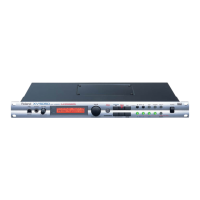71
Chapter 4 Using the XV-5050 Effects
Chapter 4
Setting Procedure
You can set the direct sound’s output method and the amount of
effect applied for each Tone or Rhythm Tone individually.
1.
Choose the Patch/Rhythm Set you wish to use.
2.
Press [EDIT] to make its indicator light.
3.
Press [ CURSOR] a few times to move the cursor to the
parameter group in the upper line of the display.
4.
Turn [VALUE] to choose “EFFECTS.”
5.
Press [CURSOR ] to move the cursor to the parameter.
6.
Turn [VALUE] to choose the parameter you want to set.
7.
Choose the Tone/Rhythm Tone for which you want to make
settings.
For more information on how to choose Tone/Rhythm Tone,
refer to pages 39 and 56.
8.
Press [CURSOR ] to move the cursor to the value.
9.
Turn [VALUE] to select the desired setting.
10.
Press [EXIT] to return to the PATCH/RHYTHM PLAY screen.
A “*” symbol appears at the left of the Patch/Rhythm Set name,
indicating that its settings have been changed.
If you turn off the power or choose another Patch/Rhythm Set
while the “*” symbol is displayed, your new Patch/Rhythm Set
settings will be lost. If you wish to preserve them, save the
changed Patch/Rhythm Set using the Write operation. (p. 104)
• When the Output Assign parameter (p. 40)/(p. 55) is set to
anything but TONE, the setting made here has no effect.
• When the Struct Type (PATCH:COMMON) parameter has a
setting of Type 2–10, the outputs of Tones 1 and 2 will be
combined with Tone 2, and the outputs of Tones 3 and 4 will be
combined with Tone 4. For this reason, the setting of Tone 1 will
follow the setting of Tone 2, and the setting of Tone 3 will follow
the setting of Tone 4 (p. 41).
• When outputting in mono, the Pan setting is disabled.
• Chorus and Reverb are output in mono at all times.
• When the settings are such that signals are split and output from
the INDIVIDUAL 1 jack and INDIVIDUAL 2 jack, and no plug is
inserted in the INDIVIDUAL 2 jack, the sounds from
INDIVIDUAL 1 and INDIVIDUAL 2 are mixed together, then
output from the INDIVIDUAL 1 jack. This sound comprises the
sounds from the INDIVIDUAL 1 and 2 jacks.
If the Mix/Parallel parameter (SYSTEM:GENERAL) is set to
MIX, all sounds are output from the OUTPUT A (MIX) jacks in
stereo (p. 107).
For more on how to set each effect, refer to the pages shown
below.
• Multi-effects -> (p. 74, pp. 75–101)
• Chorus -> (p. 74, p. 102)
• Reverb -> (p. 74, p. 103)
Parameter
Value Description
EFFECTS
Output Asgn
Tone Output Assign MFX, OUTPUT A/B,
INDIV 1–4
Sets the direct sound’s output method for each Tone or Rhythm Tone.
MFX:
Output in stereo through Multi-effects. You can also apply Chorus or Reverb to the sound that
passes through Multi-effects.
OUTPUT A/B:
Output to the OUTPUT A (MIX) / B jacks in stereo without passing through Multi-
effects.
INDIV 1–4:
Output to the INDIVIDUAL 1–4 jack in mono without passing through Multi-effects.
Output Level
Tone Output Level 0–127 Sets the direct sound’s volume for each Tone or Rhythm Tone. When Multi-effects are be-
ing applied, this sets the amount of the effect that is applied; when Multi-effects are not
applied, this sets the volume of the direct sound.
Chorus Send Tone Chorus Send Level 0–127 Sets the chorus depth for individual Tone/Rhythm Tone. If you don’t want to add the
Chorus effect, set it to 0.
Reverb Send Tone Reverb Send Level 0–127 Sets the reverb depth for individual Tone/Rhythm Tone. If you don’t want to add the Re-
verb effect, set it to 0.
XV-5050_e.book 71 ページ 2003年6月27日 金曜日 午後3時14分

